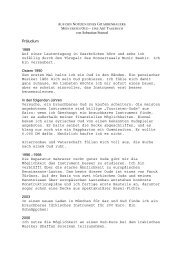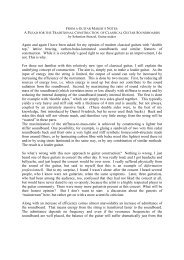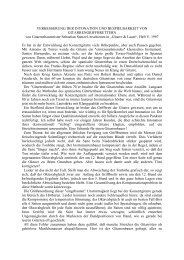INTERVIEW WITH SEBASTIAN STENZEL - Stenzel Guitars
INTERVIEW WITH SEBASTIAN STENZEL - Stenzel Guitars
INTERVIEW WITH SEBASTIAN STENZEL - Stenzel Guitars
Create successful ePaper yourself
Turn your PDF publications into a flip-book with our unique Google optimized e-Paper software.
components, whose dimensions are fixed beforehand, ahead of time for several guitars. It requires a bit<br />
of planning, so that the neck, for example, is there when I need it. That means that I’m working on the<br />
next guitar while I’m finishing the last. It’s a new rhythm for me but I have the feeling that it benefits<br />
the quality of the instruments.<br />
There are always interruptions, of course, by telephone calls, but also by marketing work, writing<br />
articles or preparing presentations, and customer service. Then there are those days when I never make<br />
it into the shop or am too busy with paperwork and I hate those days. I’m often happy when I know<br />
that can work a whole day in the shop with no e-mails, no messages on the answering machine, and<br />
nothing on the agenda.<br />
When someone buys a guitar from me it’s not like he pays for it, takes it home and that’s it. I look at<br />
myself as a companion for the instrument. Of course I do the individual set up, but also track the<br />
further development of the guitar. There are often little details which make for a more contented<br />
customer, like helping find the most suitable strings and such. For me it is a matter of course that<br />
smaller service needs are included in the purchase price.<br />
Let’s talk a bit about your 12-hole bridge. Why have you opted for that type of bridge?<br />
Basically my bridge is a traditional bridge, that is to say, a bridge with tie block and a variable bridge<br />
bone. My bridges have a so-called lip in the rear which prevents or at least impedes the string end<br />
having contact with the top. It’s important to me that the bridge be light. My bridges typically weigh<br />
between 16 and 17 grams and I make them exclusively of Indian rosewood, primarily because of the<br />
weight. Most luthiers use Brazilian rosewood. If you’ll permit an aside here, I’d like to say that when<br />
talking about individual components of the guitar you can never say that this is better than that,<br />
because it all depends on the overall concept of construction. So a bridge made of Brazilian rosewood<br />
might easily be the right choice if it makes sense in the overall concept. I like to say that the bridge is<br />
the „gearing“ of the guitar because it transfers the string vibration to the body. A heavy bridge supports<br />
and improves the sustain simply because of it’s larger mass and brings about a longer turn-on time of<br />
the tone. There are, however, some minus points of a heavier bridge which affect the attack and<br />
modulation. I always make my bridges of tangentialy-sawn wood so that the annual rings run parallel<br />
to the top because of the greater flexibility that the bridge has that way. Quartersawn would be stiffer<br />
and emphazise its function for the structural stability. I’m really not sure how important this is, but I<br />
believe that even elements whose direct influence is perhaps not provable, taken as a whole, they do<br />
have an effect.<br />
My bridges are relatively small—17 cm long and 29.5 cm wide. The width is standard, but the length<br />
is relatively short. It’s important that the bridge ends are free, and by that I mean that there are no fan<br />
braces running over the bridge ends which would bring about a dampening effect.<br />
It’s important that strings sit well over the bridge. For a time now I’ve been using the so-called<br />
double-hole system for two reasons. First of all for aesthetic reasons. I think it looks elegant and<br />
second, it allows more pressure to be put on the bridge bone. You just have to be careful that the angle<br />
of the string is not so acute that the wound bass strings are bent too much. I think that high string<br />
pressure on the bridge improves the quality of tone.<br />
The fit of the bridge bone is very important. It has to be perfect—not too tight so that it sticks, but not<br />
too loose either. When the bridge bone is stuck it compromises the trebles, especially the high Estring.<br />
I can’t explain why that is, but I discovered it accidentally and it’s confirmed itself since then<br />
over and over. Sometimes I can perform it like a trick, when a customer complains that his high E






